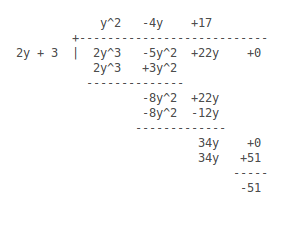How do you long divide #2y^3 - 5y^2+ 22y# by #2y+3#?
1 Answer
Long dividing polynomials is similar to long dividing integers. See explanation for details.
Result:
Explanation:

Please excuse the poor formatting, but it's the easiest way to get the symbols to line up.
Write down the polynomial dividend under the bar in standard form with descending powers of the variable (in this case
Write down the polynomial divisor outside the bar to the left. Also write it in standard form, adding any missing powers with a
Write the first term of the quotient above the bar, choosing it to match the highest order term of the dividend when multiplied by the highest order term of the divisor. In our case, we write down
Write down the result of multiplying the first term of the quotient by the divisor below the dividend.
Subtract to get a remainder (in our case
Write down the next term
Write down the result (
Keep going in similar fashion until we're left with a remainder

